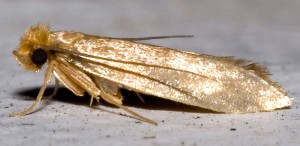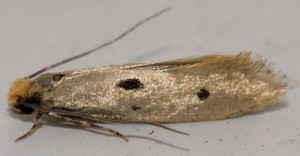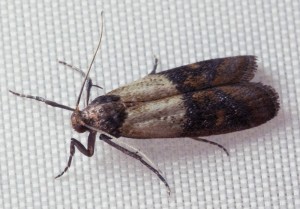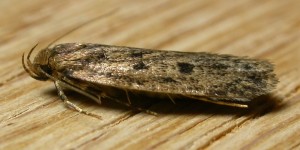If you discover moths in your home, they are typically one of the following species:
- Clothes moth
- Case-bearing clothes moth
- Two-spotted meal moth
- Meal moth
Below, you can learn more about these four species, their behavior, and how they typically manifest in homes.
Clothes Moth
Food: The larvae of clothes moths feed mainly on organic textiles such as wool, silk, and feathers. In practice, it is often stored clothing or other textiles that clothes moth larvae attack. Clothes moths can only survive indoors and not in nature.
Signs: If you find holey clothing that may also be stained with small white droppings and webbing (from the larvae), it could be due to clothes moths. However, case-bearing clothes moths and meal moths can also cause similar damage to textiles.
Control: Controlling clothes moths involves three steps: 1) thoroughly inspect all textiles for larvae and eggs, 2) clean all textiles and storage areas, and 3) store all textiles in tightly sealed bags. More detailed instructions can be found via the link below.
Read more about clothes moths here.
Case-bearing Clothes Moth
Food: Like clothes moths, case-bearing clothes moth larvae feed on organic textiles but can also occasionally consume dry foods. They mostly attack fur but can also feed on other textile types.
Signs: If you have fur hanging in a closet and notice large patches where the fur has “fallen off,” it is most likely due to case-bearing clothes moths. Their larvae typically gnaw the fur's roots, leaving bare spots.
Control: Similar to clothes moths, controlling case-bearing clothes moths requires inspecting all textiles, cleaning them and their storage spaces, and preventing future infestations by storing textiles in airtight bags. More detailed instructions are available via the link below.
Read more about case-bearing clothes moths here.
Indian Meal Moth
Food: In the home, the larvae of Indian meal moths primarily feed on dry foods like grains, cereals, spices, bulgur, etc., but they can also consume plant materials.
Signs: Webbing in food or clumped-together food due to larvae droppings are two common signs of Indian meal moths. The larvae are usually difficult to spot. The adult moths are attracted to light, and if you see them flying or moving around, it is almost certainly a sign of an infestation.
Control: To control indian meal moths, you should: 1) inspect all foods, 2) discard all infested foods, 3) clean all kitchen cupboards, and 4) prevent future infestations by storing dry goods in airtight containers. More detailed instructions can be found via the link below.
Read more about Indian meal moths here.
Brown House Moth
Food: Brown house moth larvae have the broadest diet of all moth species commonly found in homes. They can live on organic, plant, and certain animal materials. However, in homes, brown house moths are often considered textile pests, as they typically attack fabrics.
Signs: When brown house moths infest textiles, you will notice holes in clothing, often accompanied by webbing and droppings from the larvae. When they infest food, the signs are the same as for Indian meal moths (see above).
Control: Brown house moths in homes may come from a bird's nest or even an insect colony near the house. It is crucial to inspect the surroundings if you have a brown house moth infestation. The rest of the control measures are similar to those for clothes moths, case-bearing clothes moths, or Indian meal moths, depending on whether textiles or food are affected. More detailed instructions can be found via the link below.
Read more about brown house moths here.
Moths in the Closet
Moths are generally divided into two groups based on their preferred habitats:
- Clothes moths: These moths often live in closets, drawers, basements, attics, or other undisturbed places where organic textiles are stored. If you find moths in your closet, they are almost always clothes moths or case-bearing clothes moths.
- Food moths: These moths primarily feed on dry foods found in kitchen cupboards. They prefer the enclosed, dark, and undisturbed environment of cupboards. If you find moths in your kitchen cabinet, it is likely Indian meal moths or brown house moths.
Moths in the House
Some moth species, especially brown house moths, are more commonly found in houses than apartments, particularly in homes with gardens or those near nature. These areas often have bird nests, insect colonies, carrion, or dead insects, which can be ideal for moths.
Older houses are also more susceptible to moth infestations due to cracks, crevices, and holes that moths prefer. Once established, moths can become a significant problem.
Other Species in the Home
If you discover moths in your home that do not seem to match the descriptions above, you can check our extended list of 12 moth species here.
You can also use the comparison chart on our moth-themed homepage to compare different species.




